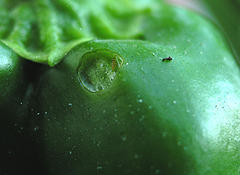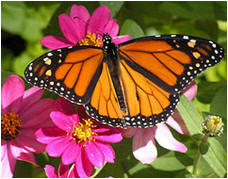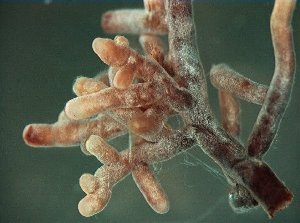Interactions
The
Hot
Peppers use a wide variety of methods to
pollinate; birds, bats, butterflies, mice, ants, water, and wind. Birds like
 the
Bald Eagle do not have the same sensitivity to capsaicin, because it
targets a specific pain receptor in mammals that birds don't
have. Hot peppers are eaten by
birds and the seeds of the peppers drop off while the birds are
eating the pods or the seeds pass through the digestive tract unharmed.
This relationship may be part of the reason w
the
Bald Eagle do not have the same sensitivity to capsaicin, because it
targets a specific pain receptor in mammals that birds don't
have. Hot peppers are eaten by
birds and the seeds of the peppers drop off while the birds are
eating the pods or the seeds pass through the digestive tract unharmed.
This relationship may be part of the reason w hy hot peppers
produce capsaicin. Birdseed will sometimes have capsaicin-based
products to deter anything that isn’t a bird. Capsaicin is also
a defense mechanism against fungi that try to get inside the pepper through holes made by insects, like the
Monarch Butterfly.
hy hot peppers
produce capsaicin. Birdseed will sometimes have capsaicin-based
products to deter anything that isn’t a bird. Capsaicin is also
a defense mechanism against fungi that try to get inside the pepper through holes made by insects, like the
Monarch Butterfly.
If you're reading this I'm assuming you are a human, so you probably want to know how hot peppers affect you. People use hot peppers in a number of different ways, ranging from the regular use to spice up food, all the way to curing tooth aches! The capsaicin is the key to why the hot pepper is so different than any other fruit you see, and the reason hot peppers are grown around the world. You will see examples of other ways the hot pepper is used in the Surprising Facts section.
The hot pepper engages in mutualistic symbiosis with the
fungi
glomeromycota. This helps the plant by bringing in necessary
nutrients it needs and helps the fungi by supplying them with
sugars. Glomeromycota produces endomycorrhizae that are in symbiosis
with the plants roots.
T he mycorrhizae receives carbohydrates from
the plant in exchange for functioning as
an
extended root system, improving mineral uptake by the plant roots.
As mutualistic symbionts, arbuscular mycorrhizal fungi are able to
grow inside the plant roots without causing any diseases. They are
obligate symbionts because no one has ever been able to grow
glomeromycota separately from a plant host. Once they invade the
root, they usually form tree-shaped structures called arbuscules
that often fill the root cells. Because the cell walls of both
symbionts are much thinner along the surface of the arbuscule
branches, both symbiotic partners are brought into very close
contact. Want to check out another plant that uses this same type of
symbiosis? Click
here!
he mycorrhizae receives carbohydrates from
the plant in exchange for functioning as
an
extended root system, improving mineral uptake by the plant roots.
As mutualistic symbionts, arbuscular mycorrhizal fungi are able to
grow inside the plant roots without causing any diseases. They are
obligate symbionts because no one has ever been able to grow
glomeromycota separately from a plant host. Once they invade the
root, they usually form tree-shaped structures called arbuscules
that often fill the root cells. Because the cell walls of both
symbionts are much thinner along the surface of the arbuscule
branches, both symbiotic partners are brought into very close
contact. Want to check out another plant that uses this same type of
symbiosis? Click
here!
Here comes the fun part (not to say anything before this wasn't a blast)! Click here to learn about how hot peppers are being used as a hangover cure!
